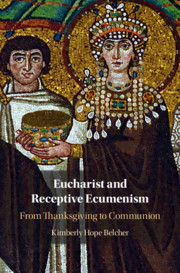Book contents
- Eucharist and Receptive Ecumenism
- Eucharist and Receptive Ecumenism
- Copyright page
- Contents
- Tables
- Preface
- Acknowledgments
- 1 The Call of Unity
- 2 Diversity Is the Tradition
- 3 A Phenomenology of Giving Thanks
- 4 Eucharistia and Revelation
- 5 Ambrose’s Words and the Roman Canon
- 6 Augustine and the Assembly’s Destiny
- 7 Consecrating and Offering the Ordinary
- 8 The Eschatological Exception
- 9 Outdo One Another in Showing Honor
- 10 Into the Heart of God
- Bibliography
- Index
6 - Augustine and the Assembly’s Destiny
Published online by Cambridge University Press: 16 October 2020
- Eucharist and Receptive Ecumenism
- Eucharist and Receptive Ecumenism
- Copyright page
- Contents
- Tables
- Preface
- Acknowledgments
- 1 The Call of Unity
- 2 Diversity Is the Tradition
- 3 A Phenomenology of Giving Thanks
- 4 Eucharistia and Revelation
- 5 Ambrose’s Words and the Roman Canon
- 6 Augustine and the Assembly’s Destiny
- 7 Consecrating and Offering the Ordinary
- 8 The Eschatological Exception
- 9 Outdo One Another in Showing Honor
- 10 Into the Heart of God
- Bibliography
- Index
Summary
Having considered the interconnected acts of accepting and offering, and looked at the role that the bread and wine play as created elements and covenant gifts, I turn more explicitly to their dual character as body of Christ. This includes the consecration of the gifts, interpreted in the Roman theological tradition as rendering substantially present the historical and risen body and blood of Jesus. It also incorporates the so-called mystical (earlier, the real) ecclesial body of Christ.1 As suggested in Chapter 4, the Eucharist is not thanksgiving and also a sacrifice of praise, in the sense that during the same service in which the assembly gives thanks, it also offers the eucharistic gifts and praise to the Father. Rather, it is essentially a sacrifice of praise, within which the offering of the eucharistic gifts plays an essential role in uncovering the givenness of Christ the gift and provoking the conversion of the assembly. These two theological ideas cannot be separated from one another, because the Eucharist’s ultimate purpose is the eschatological convocation of the saints in Christ’s one body, but this is brought about by means of the immersion of those saints into the crucified, risen, and glorified body.
- Type
- Chapter
- Information
- Eucharist and Receptive EcumenismFrom Thanksgiving to Communion, pp. 119 - 140Publisher: Cambridge University PressPrint publication year: 2020



